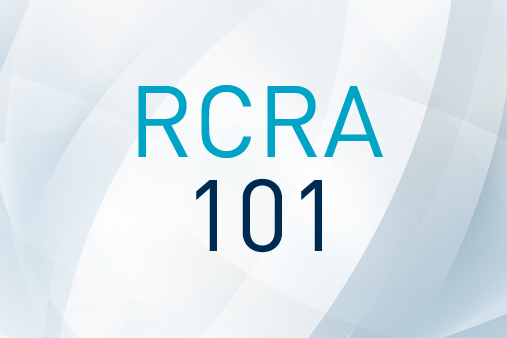To characterize and dispose of a hazardous waste, the generator of that waste must assign the proper “waste code(s)”. Waste codes communicate the properties and hazards of the waste, determine treatment requirements, and govern how it must be stored, transported, and handled. The United States Environmental Protection Agency (EPA) establishes two categories of hazardous wastes (with associated waste codes) as part of the Resource, Conservation and Recovery Act (RCRA) in title 40 of the Code of Federal Regulations (CFR) part 261: Characteristic and Listed.
Characteristic Hazardous Wastes
A RCRA “characteristic” hazardous waste exhibits at least one of four characteristics defined in 40 CFR § 261.21 through 261.24: ignitability (D001), corrosivity (D002), reactivity (D003), and toxicity (D004 – D043). The testing parameters to determine the applicability of characteristic waste codes are also listed in the same section.
Listed Hazardous Wastes
A waste is determined to be a “Listed” hazardous waste if it is specifically listed on one of four lists (the F, K, P and U lists) found in 40 CFR part 261. Listed waste codes are assigned to individual chemicals (when present as the sole active ingredient) or assigned according to their source (specific or non-specific).
- The F list (non-specific source wastes) – The F list designates particular solid wastes as hazardous from certain industrial or manufacturing processes. Because the processes producing these wastes can occur in different sectors of industry, the F list wastes are known as wastes from “nonspecific sources”. Wastes included on the F list are found in the regulations at 40 CFR § 261.31.
- The K list (source-specific wastes) – The K list designates solid wastes from certain specific industries as hazardous. Wastes included on the K list are found in the regulations at 40 CFR § 261.32.
- The P list and the U list (discarded commercial chemical products) – These two lists are similar in that both list, as hazardous, certain commercial chemical products when they are discarded or intended to be discarded. These listings consist of commercial chemical products having the generic names listed, off-specification species, container residues, and spill residues. The difference is that the chemicals on the P list are identified as acute hazardous wastes and those on the U list are identified as toxic wastes. Some chemicals on both lists may also be designated to have other properties. Wastes included on the P and U lists can be found in the regulations at 40 CFR § 261.33.
State Regulated Waste Codes
In addition to the previously described Characteristic and Listed Hazardous waste codes required by the USEPA, many states have state-specific hazardous and non-hazardous waste codes. State specific waste codes, and their applicability, are generally incorporated into the state environmental regulations and can be found by reading the respective solid waste regulations. State specific waste codes often place more stringent treatment and handling requirements on specific types of wastes and can also serve to keep track of the amount of certain types of wastes being imported or exported from the state. Many treatment facilities will require that all state specific waste codes be identified for both the state where the waste is generated (generator state) and the state where it will be disposed of (destination state).
Assigning Waste Codes
Assigning the proper waste codes is critical to protect the environment from pollution and shield your business from civil penalties, bad publicity, and future liability. The US EPA provides detailed guidance for waste characterization at 40 CFR §262.11, and as always your WTS representative is available to discuss any questions you may have on the matter.

